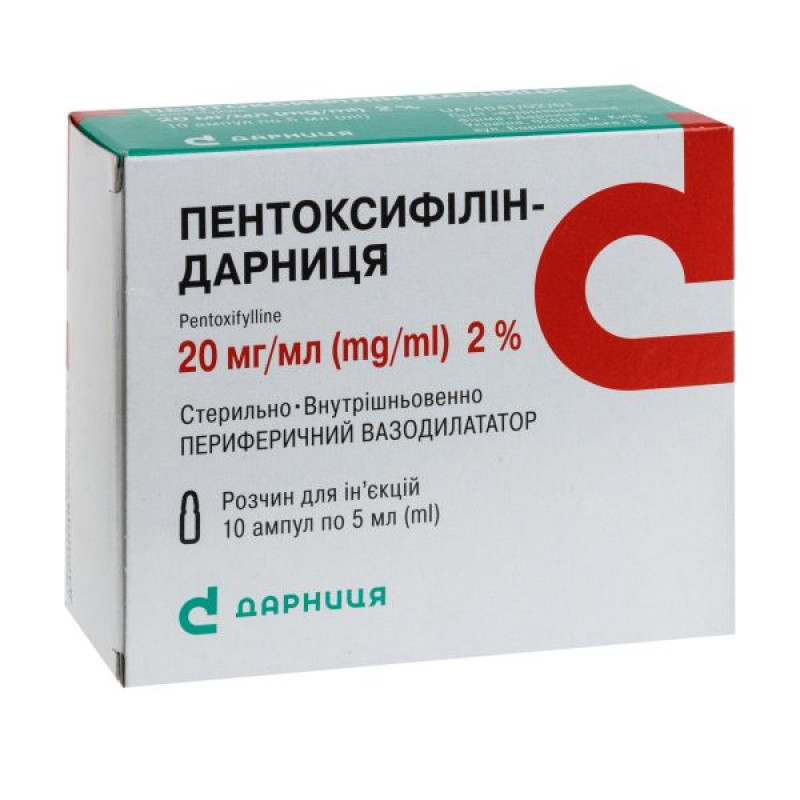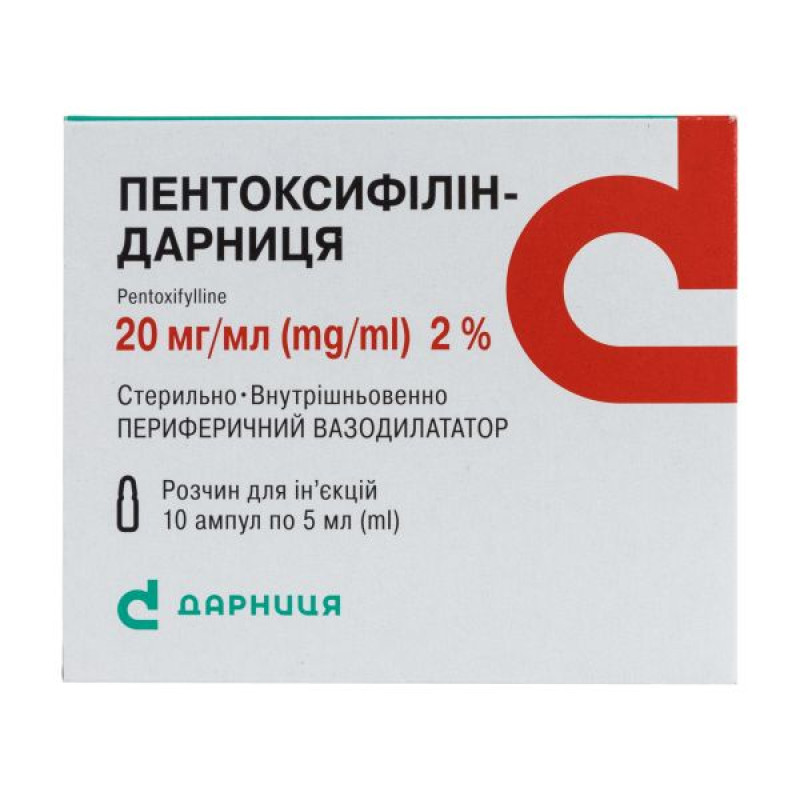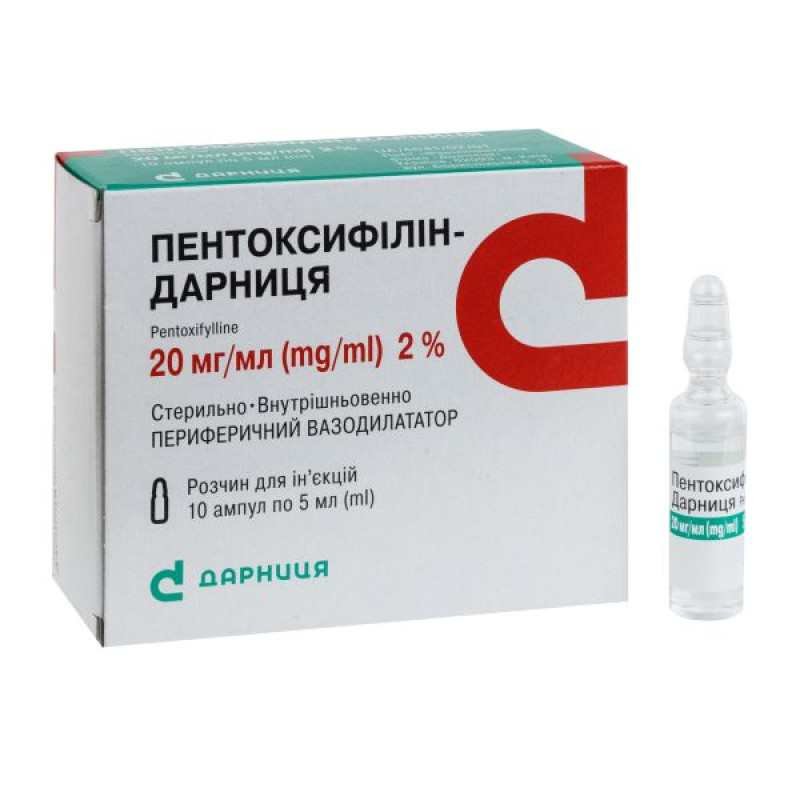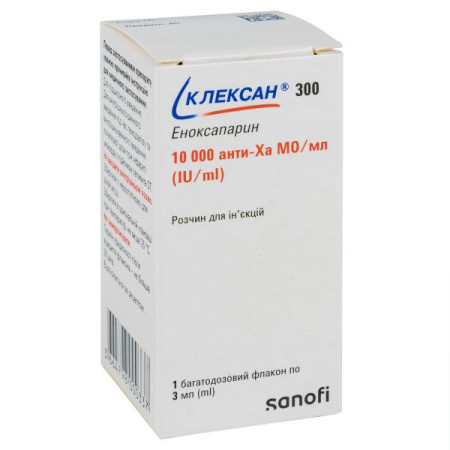Pentoxifylline-Darnitsa solution for injection 20 mg/ml ampoule 5 ml No. 10

Instructions Pentoxifylline-Darnitsa solution for injection 20 mg/ml ampoule 5 ml No. 10
Composition
active ingredient: pentoxifylline;
1 ml of solution contains 20 mg of pentoxifylline;
Excipients: sodium chloride, water for injections.
Dosage form
Solution for injection.
Main physicochemical properties: clear colorless liquid.
Pharmacotherapeutic group
Peripheral vasodilators. Purine derivatives. ATC code C04A D03.
Pharmacological properties
Pharmacodynamics.
Pentoxifylline is a methylxanthine derivative. The mechanism of action of pentoxifylline is associated with the inhibition of phosphodiesterase and the accumulation of cAMP in vascular smooth muscle cells, blood cells, as well as in other tissues and organs. Pentoxifylline inhibits platelet and erythrocyte aggregation, increases their flexibility, reduces the increased concentration of fibrinogen in blood plasma and enhances fibrinolysis, which reduces blood viscosity and improves its rheological properties. In addition, pentoxifylline causes a weak myotropic vasodilator effect, slightly reduces total peripheral vascular resistance and has a positive inotropic effect. As a result of the use of pentoxifylline, microcirculation and oxygen supply to tissues improve, most of all - in the extremities, central nervous system, moderately - in the kidneys. The drug slightly dilates coronary vessels.
Pharmacokinetics.
The main pharmacologically active metabolite 1-(5-hydroxyhexyl)-3,7-dimethylxanthine (metabolite I) is detected in blood plasma at a concentration that is 2 times higher than the concentration of the unchanged substance and is in a state of reverse biochemical equilibrium with it. Therefore, pentoxifylline and its metabolite should be considered as an active whole.
The half-life of pentoxifylline is 1.6 hours.
Pentoxifylline is completely metabolized, more than 90% is excreted by the kidneys in the form of unconjugated water-soluble polar metabolites. Less than 4% of the administered dose is excreted in the feces. In patients with severe renal impairment, excretion of metabolites is slowed down. In patients with hepatic impairment, the half-life of pentoxifylline is prolonged.
Indication
Atherosclerotic encephalopathy; ischemic cerebral stroke; dyscirculatory encephalopathy; peripheral circulatory disorders caused by atherosclerosis, diabetes mellitus (including diabetic angiopathy), inflammation; trophic disorders in tissues associated with damage to veins or impaired microcirculation (postthrombophlebitic syndrome, trophic ulcers, gangrene, frostbite); obliterating endarteritis; angioneuropathy (Raynaud's disease); circulatory disorders of the eye (acute, subacute, chronic circulatory insufficiency in the retina and choroid of the eye); disorders of the function of the inner ear of vascular genesis, which are accompanied by hearing loss.
Contraindication
Hypersensitivity to pentoxifylline, other components of the drug or to other drugs of the methylxanthine group;
massive bleeding (risk of increased bleeding);
hemorrhages in the retina, brain; if retinal hemorrhage occurs during treatment with pentoxifylline, the drug should be discontinued immediately;
hemorrhagic diathesis;
acute myocardial infarction;
stomach ulcer and/or intestinal ulcers;
pregnancy.
Interaction with other medicinal products and other types of interactions
The simultaneous use of pentoxifylline and antihypertensive drugs (in particular, angiotensin-converting enzyme inhibitors) enhances the effect of the latter, which may cause a decrease in blood pressure, therefore, appropriate adjustment of the doses of antihypertensive drugs is necessary.
Anticoagulants, drugs that reduce blood coagulation. The simultaneous use of pentoxifylline and drugs that reduce blood coagulation increases the risk of bleeding, so prothrombin time should be monitored more frequently. In the post-marketing period, cases of increased anticoagulant activity have been reported in patients who were simultaneously treated with pentoxifylline and vitamin K antagonists. When prescribing or changing the dosage of pentoxifylline, it is recommended to monitor anticoagulant activity in this group of patients.
Cimetidine. When administered simultaneously with cimetidine, a significant increase in the concentration of pentoxifylline in the blood serum occurs. It is necessary to carefully monitor for possible signs of pentoxifylline overdose. Other H2-receptor antagonists (famotidine, ranitidine and nizatidine) have a much smaller effect on the metabolism of pentoxifylline.
Theophylline. Simultaneous administration of pentoxifylline and theophylline may lead to an increase in the concentration of theophylline in the blood serum. Therefore, an increase in the frequency and severity of theophylline adverse reactions may occur. The concentration of theophylline in the blood serum should be monitored and, if necessary, its dose should be reduced.
Ciprofloxacin. Ciprofloxacin inhibits the metabolism of pentoxifylline in the liver, so the simultaneous use of pentoxifylline and ciprofloxacin may lead to an increase in the concentration of pentoxifylline in the blood serum. As a result, the frequency and severity of adverse reactions associated with the simultaneous use of drugs may increase. If it is necessary to conduct simultaneous treatment with pentoxifylline and ciprofloxacin, it is recommended to halve the dose of pentoxifylline.
Insulin and oral antidiabetic drugs. Large intravenous doses of pentoxifylline may enhance the hypoglycemic effects of insulin and oral antidiabetic drugs, so the dosage of insulin or hypoglycemic drug should be adjusted accordingly. Patients receiving drug treatment for diabetes should be closely monitored.
Nitrates. Pentoxifylline enhances the effect of nitrates.
Erythromycin. There is no data on the possible interaction of pentoxifylline and erythromycin. However, with the combined use of pentoxifylline and erythromycin, an increase in plasma theophylline levels with manifestations of toxic reactions is noted.
Platelet aggregation inhibitors: Due to the increased risk of bleeding, concomitant use of platelet aggregation inhibitors (e.g. clopidogrel, eptifibatide, tirofiban, epoprostenol, iloprost, abciximab, anagrelide, non-steroidal anti-inflammatory drugs (NSAIDs) other than selective COX-2 inhibitors, acetylsalicylates (acetylsalicylic acid (ASA)/lysine acetylsalicylate (LAS), ticlopidine, dipyridamole) with pentoxifylline should be done with caution.
Application features
At the first signs of an anaphylactic/anaphylactoid reaction, drug therapy should be discontinued and medical attention should be sought.
When using pentoxifylline in patients with chronic heart failure, the phase of circulatory compensation should first be achieved.
In patients with diabetes and treated with insulin or oral antidiabetic agents, the effect of these drugs on blood sugar levels may be increased when high doses of the drug are used (see section "Interaction with other medicinal products and other types of interactions"). In these cases, the dose of insulin or oral antidiabetic agents should be reduced and the patient should be closely monitored.
Particularly careful monitoring is necessary in patients receiving simultaneous treatment with pentoxifylline and ciprofloxacin (see section "Interaction with other medicinal products and other types of interactions").
Patients with systemic lupus erythematosus (SLE) or other connective tissue diseases should only be prescribed pentoxifylline after a thorough analysis of the potential risks and benefits.
Since there is a risk of developing aplastic anemia during treatment with pentoxifylline, regular monitoring of complete blood counts is required.
In patients with renal insufficiency (creatinine clearance less than 30 ml/min) or severe liver dysfunction, the elimination of pentoxifylline may be delayed. Appropriate monitoring is required.
Particularly careful observation is necessary for patients:
with severe cardiac arrhythmias;
with myocardial infarction;
with arterial hypotension;
with severe atherosclerosis of cerebral and coronary vessels, especially with concomitant arterial hypertension and heart rhythm disturbances. In such patients, angina attacks, arrhythmias and arterial hypertension are possible when using the drug;
with renal failure (creatinine clearance below 30 ml/min);
with severe liver failure;
with a high tendency to bleed, for example due to treatment with anticoagulants or blood clotting disorders. For bleeding, see the section "Contraindications";
with a history of gastric and duodenal ulcers, patients who have recently undergone surgical treatment (increased risk of bleeding, which requires systematic monitoring of hemoglobin and hematocrit levels);
for whom a decrease in blood pressure is a high risk (for example, patients with severe ischemic heart disease or stenosis of the vessels supplying blood to the brain);
who are simultaneously receiving treatment with pentoxifylline and vitamin K antagonists (see section “Interaction with other medicinal products and other types of interactions”);
who are simultaneously receiving treatment with pentoxifylline and antidiabetic agents (see section "Interaction with other medicinal products and other types of interactions").
Important information about excipients.
This medicinal product contains 9 mg/ml sodium. Caution should be exercised when used in patients on a controlled sodium diet.
Use during pregnancy or breastfeeding
Pregnancy.
There is insufficient experience with the use of the drug in pregnant women. Therefore, the drug should not be prescribed during pregnancy.
Breast-feeding.
Pentoxifylline passes into breast milk in small amounts. If treatment with pentoxifylline is prescribed, breastfeeding should be discontinued.
Ability to influence reaction speed when driving vehicles or other mechanisms
Method of administration and doses
Intravenous infusions are the most effective and well-tolerated forms of parenteral administration of the drug. The dosage regimen is determined by the doctor and depends on the severity of circulatory disorders, body weight and tolerability of the treatment. Infusion can be carried out only if the solution is clear.
The following treatment regimens are recommended for adults:
Intravenous infusion of 100–600 mg of pentoxifylline in 100–500 ml of Ringer's lactate solution, 0.9% sodium chloride solution or 5% glucose solution 1–2 times a day. The duration of the intravenous drip infusion is 60–360 minutes, i.e. the administration of 100 mg of pentoxifylline should last at least 60 minutes. The infusion can be supplemented with oral administration of pentoxifylline (400 mg) with the calculation that the maximum daily dose (infusion and oral) is 1200 mg.
In severe cases of the patient (especially in case of persistent pain, gangrene or trophic ulcers), it is possible to carry out an infusion of pentoxifylline for 24 hours. With this scheme of administration, the dose is determined at the rate of 0.6 mg/kg/h. The daily dose calculated in this way for a patient weighing 70 kg is 1000 mg, for a patient weighing 80 kg - 1150 mg. Regardless of the patient's body weight, the maximum daily dose is 1200 mg.
The volume of infusion solution is calculated individually, taking into account concomitant diseases and the patient's condition, and is on average 1–1.5 liters per day.
In some cases, the drug is administered by intravenous injection of 5 ml (100 mg). The injection should be administered slowly, over 5 minutes, with the patient in the supine position.
The duration of parenteral therapy is determined by the treating physician. After the patient's condition improves, it is recommended to continue treatment using the tablet form of the drug.
Children.
There is no experience with the use of the drug in children.
Overdose
Symptoms: weakness, nausea, dizziness, decreased/increased blood pressure, fainting, arrhythmia, tachycardia, drowsiness or agitation, loss of consciousness, hyperthermia, areflexia, tonic-clonic seizures, signs of gastrointestinal bleeding - vomiting (vomiting the color of coffee grounds), fever, feeling of heat (hot flashes).
Treatment: at the first symptoms of overdose (sweating, nausea, cyanosis) immediately stop using the drug. It is necessary to ensure a lower position of the head and upper body, monitor the patency of the respiratory tract. Conduct symptomatic therapy, special attention should be paid to maintaining blood pressure and respiratory function. To stop convulsive seizures, administer diazepam.
Adverse reactions
On the part of the organs of vision: visual impairment, scotoma, lacrimation, conjunctivitis, retinal hemorrhages, retinal detachment.
From the side of the organs of hearing and vestibular apparatus: earache.
Gastrointestinal: gastrointestinal disorders, feeling of pressure in the stomach, stomach fullness, diarrhea, nausea, vomiting (including repeated), flatulence, epigastric pain, anorexia, intestinal atony, constipation, dry throat, thirst.
From the liver and biliary tract: intrahepatic cholestasis, increased activity of liver enzymes, exacerbation of cholecystitis, cholestatic hepatitis.
From the side of metabolism: hypoglycemia, hypokalemia.
Nervous system: headache, migraine, dizziness, aseptic meningitis (when using high doses), hand tremor, insomnia, agitation, restlessness, feeling of fear, loss of consciousness, sleep disturbances, hallucinations, darkening in the eyes, numbness of the extremities, hyperhidrosis, convulsions, paresthesia.
Cardiovascular system: tachycardia, peripheral edema, facial flushing or feeling of heat (hot flashes), angina pectoris, atypical chest pain, hypotension, hypertension, shortness of breath, feeling of lack of air, arrhythmia, palpitations.
Blood and lymphatic system disorders: thrombocytopenia with thrombocytopenic purpura, leukopenia/neutropenia, pancytopenia (which can be fatal), prolonged prothrombin time, hypofibrinogenemia, anemia, aplastic anemia, bleeding (e.g. from skin vessels, mucous membranes, stomach, intestines, nose).
On the part of the immune system: allergic reactions (anaphylactic/anaphylactoid reactions up to anaphylactic shock, angioedema, bronchospasm, skin redness, itching, rash, urticaria), toxic epidermal necrolysis (Lyell's syndrome), Stevens-Johnson syndrome.
Skin and subcutaneous tissue disorders: increased sweating, hyperemia of the skin of the face and upper chest, edema, maculopapular rashes, dermatitis, increased nail fragility.
General disorders and administration site conditions: taste disturbance, increased salivation, malaise, sore throat/neck, laryngitis, nasal congestion, weight gain/loss, chills, fever, hyperthermic syndrome; injection site pain, hyperemia, edema, rash.
Laboratory indicators: increased activity of hepatic transaminases (ALT, AST, LDH) and alkaline phosphatase.
Most adverse reactions are dose-related and can be minimized or avoided by reducing the dose.
If severe adverse reactions occur, treatment should be discontinued.
Reporting suspected adverse reactions after the marketing authorisation of a medicinal product is an important procedure. It allows for continued monitoring of the benefit-risk balance of the medicinal product in question. Healthcare professionals should report any suspected adverse reactions via the national reporting system.
Expiration date
3 years.
Storage conditions
Store in the original packaging at a temperature not exceeding 25 ° C. Do not freeze.
Keep out of reach of children.
Incompatibility.
The drug should not be mixed with other medicines in the same container, except for the solutions specified in the "Method of administration and dosage" section.
Packaging
5 ml in an ampoule; 5 ampoules in a contour blister pack; 1 or 2 contour blister packs in a pack.
Vacation category
According to the recipe.
Producer
PrJSC "Pharmaceutical Company "Darnitsa".
Location of the manufacturer and address of its place of business
Ukraine, 02093, Kyiv, Boryspilska St., 13.
There are no reviews for this product.
There are no reviews for this product, be the first to leave your review.
No questions about this product, be the first and ask your question.
















